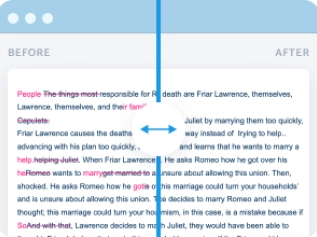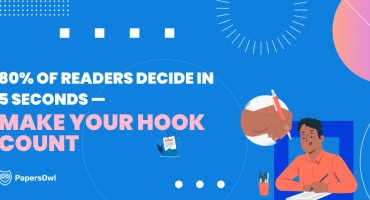How to Write a Scholarship Essay
Table of contents
How do you write a scholarship essay?
Start by carefully reading the prompt and word limit, then choose a personal story that reflects your strengths, values, and goals.
Structure your essay with a strong hook, clear body paragraphs, and a thoughtful conclusion that shows gratitude and explains how the scholarship will impact your future.
Avoid clichés, stay authentic, and always tailor your essay to the mission of the scholarship provider.
Key Takeaways:
- Answer the exact prompt;
- Share a personal, authentic story;
- Follow format and word limits;
- Show how the award supports your goals;
- End with gratitude and confidence.
If you feel stuck, a professional scholarship essay writing service can help you organize ideas and polish your draft — but the most powerful essays always keep your unique voice. Winning essays are personal, specific, and demonstrate growth, motivation, and impact.
How to Write a College Scholarship Essay
Writing a strong scholarship essay isn’t about stuffing in keywords — it’s about clarity, authenticity, and a story that matches the scholarship’s mission. Here’s a simple process you can follow:
- Research the donor’s mission. Read the prompt carefully and note what values or qualities they emphasize.
- Choose one personal story. Focus on a meaningful experience that highlights your strengths and goals.
- Start with impact. Use a powerful opening line — explore practical tips on writing a good hook to grab attention.
- Show your contribution. Explain how your experience shaped you and how you’ll use the scholarship to create change.
- Connect to the future. Tie your goals back to education, career, and the community.
- Revise and polish. Edit for flow, grammar, and authenticity so your voice stands out.
Scholarship Essay Format
When learning how to write a scholarship essay, start by checking the official guidelines of the program. Every scholarship provider has its own rules, and following them shows attention to detail.
Two common formats:
-
Online textbox submissions: If the application asks you to paste your essay into a textbox, you usually don’t need a title or separate pages. Just focus on the word or character limit.
-
Uploaded documents (DOC/PDF): Use standard academic style unless the program specifies otherwise:
- Font: Times New Roman, Arial, or Calibri
- Size: 12 pt
- Spacing: 1.5 or double
- Margins: 1 inch on all sides
- Length: about 1–2 pages (250–600 words)
What to include in each section:
- Introduction: Grab attention with a strong opening. Use effective strategies to craft a memorable hook.
- Body paragraphs: Highlight your experiences, challenges, and achievements that connect with the scholarship’s mission. If you also need to write a college personal statement, avoid repeating the same content — instead, adapt your story for each prompt.
- Conclusion: Summarize your main points, show gratitude, and explain how the scholarship will help your future goals.
A well-structured format makes your essay clear, professional, and more persuasive to the selection committee.
Top 10 Scholarship Prompts
When approaching scholarship essay prompts, it’s essential to structure your responses effectively. Below are 10 common scholarship prompts with a clear goal, outline skeleton, hook ideas, and typical mistakes to avoid. This will help you stay focused and craft compelling essays.
1) Tell us about yourself.
Goal: Showcase your personality, values, and unique qualities.
✍️ Outline:
- Introduction: Start with a personal story or a defining moment.
- Body: Discuss your passions, accomplishments, and how they shape you.
- Conclusion: Tie it back to your goals and why you’re applying.
💡 Hook ideas:
- “From a young age, I learned the value of hard work when…”
- “One event changed my perspective on life — and shaped who I am today…”
⚠️ Common mistakes:
- Writing a resume-style essay. Make it personal, not just a list of achievements.
2) Why do you deserve this scholarship?
Goal: Highlight your dedication, hard work, and financial need.
✍️ Outline:
- Introduction: Share why this scholarship is essential for your goals.
- Body: Explain your efforts and how they align with the scholarship’s mission.
- Conclusion: Restate your determination and future impact.
💡 Hook ideas:
- “I’ve always believed that opportunity is earned, not given. This scholarship is a stepping stone to my dream of…”
- “This scholarship will enable me to give back to my community in ways I could never imagine…”
⚠️ Common mistakes:
- Not connecting personal achievements with the mission of the scholarship.
3) How will this scholarship help you achieve your goals?
Goal: Demonstrate how the scholarship will directly impact your academic and career aspirations.
✍️ Outline:
- Introduction: Mention your long-term goals and aspirations.
- Body: Explain how this scholarship removes barriers and opens doors for your education.
- Conclusion: Show the ripple effect of receiving the scholarship.
💡 Hook ideas:
- “Imagine being able to focus entirely on my studies, without worrying about financial obstacles…”
- “This scholarship is the key to unlocking a future where I can contribute to the field of…”
⚠️ Common mistakes:
- Focusing too much on personal hardships without connecting to the scholarship’s purpose.
4) What are your academic and career goals?
Goal: Articulate a clear vision for your future.
✍️ Outline:
- Introduction: Discuss your passion for the field and your academic journey.
- Body: Break down your specific goals and the steps you’re taking to achieve them.
- Conclusion: Tie everything back to the scholarship’s role in helping you succeed.
💡 Hook ideas:
- “Ever since I was a child, I knew I wanted to be a scientist, but it wasn’t until high school that I realized how…”
- “I’ve always dreamed of becoming a doctor, but this scholarship would make my goal a reality…”
⚠️ Common mistakes:
- Lacking specificity or giving overly broad answers.
5) Describe a challenge you’ve overcome.
Goal: Show resilience and how you’ve grown from challenges.
✍️ Outline:
- Introduction: Briefly describe the challenge you faced.
- Body: Focus on the steps you took to overcome it.
- Conclusion: Reflect on the lessons learned and how it shaped you.
💡 Hook ideas:
- “When I lost my father, I thought I had lost everything, but I learned that…”
- “The biggest challenge of my life wasn’t academic, it was personal, and here’s how it changed me…”
⚠️ Common mistakes:
- Being too vague or not showing how the challenge shaped your personal growth.
6) What is your greatest accomplishment?
Goal: Highlight a key achievement that reflects your values and character.
✍️ Outline:
- Introduction: Introduce your accomplishment.
- Body: Describe the effort it took to achieve it and why it matters to you.
- Conclusion: Reflect on the impact of this accomplishment on your life.
💡 Hook ideas:
- “When I organized the first-ever community fundraiser, I saw the true power of teamwork…”
- “My greatest accomplishment isn’t a medal or a trophy, but the impact I’ve had on others…”
⚠️ Common mistakes:
- Choosing an accomplishment that isn’t relevant to the scholarship’s goals.
7) What inspires you?
Goal: Show your motivations and the driving force behind your goals.
✍️ Outline:
- Introduction: Describe what inspires you and why.
- Body: Explain how this inspiration fuels your academic and career pursuits.
- Conclusion: Tie this inspiration back to the scholarship’s mission.
💡 Hook ideas:
- “Ever since I was young, I’ve been inspired by the resilience of my mother, who taught me that…”
- “The way that art has shaped my community inspires me to one day become a creator who can change the world…”
⚠️ Common mistakes:
- Not connecting inspiration to actionable goals or personal development.
8) How have you demonstrated leadership?
Goal: Showcase your leadership qualities and experiences.
✍️ Outline:
- Introduction: Define what leadership means to you and provide an example.
- Body: Highlight your leadership experiences and impact.
- Conclusion: Reflect on how your leadership will drive your future.
💡 Hook ideas:
- “Leadership isn’t about being in charge; it’s about making others feel empowered. Here’s how I did that…”
- “My leadership experience started when I realized that a good leader listens first and acts second…”
⚠️ Common mistakes:
- Giving generic or irrelevant examples of leadership.
9) How have your experiences shaped who you are?
Goal: Reflect on how past experiences have influenced your identity.
✍️ Outline:
- Introduction: Discuss a formative experience.
- Body: Explain how it shaped your character and goals.
- Conclusion: Connect this to how it will influence your future.
💡 Hook ideas:
- “The most defining moment of my life happened when I had to move to a new country, leaving everything behind…”
- “My struggles with mental health have given me a unique perspective, which I now use to inspire others…”
⚠️ Common mistakes:
- Focusing on an experience without showing its relevance to the scholarship.
10) What are your plans for the future?
Goal: Show your future aspirations and how the scholarship will help you achieve them.
✍️ Outline:
- Introduction: Describe your vision for the future.
- Body: Explain the steps you will take to achieve it.
- Conclusion: Tie this vision to how the scholarship fits into your plan.
💡 Hook ideas:
- “I’ve always dreamed of being a lawyer who fights for social justice, and this scholarship will be the first step…”
- “My goal is to revolutionize healthcare technology, and this scholarship will empower me to pursue that dream…”
⚠️ Common mistakes:
- Not clearly outlining how the scholarship will make a tangible difference.
Scholarship Essay Examples
When applying for a scholarship, your essay needs to be both concise and impactful.
Below, we’ve provided examples for three popular prompts, each with a breakdown of why they work. These examples show how to balance clarity, personal experience, and alignment with the scholarship’s mission.
If you’re also focused on crafting your college admission essay, the same principles apply.
Example 1: 100 Words
Tell Us About Yourself
“My name is Emma, and I’ve always believed in the power of community. Growing up in a small town, I volunteered at the local food pantry every summer. That experience shaped my desire to pursue social work. My goal is to become a counselor for underprivileged children, helping them overcome their challenges. I know this scholarship will give me the opportunity to attend college and begin my journey towards making a real difference in my community.”
Why it works:
- Voice: Genuine and direct, creating a personal connection.
- Specificity: Clear description of the volunteer experience that shaped career goals.
- Alignment: Tied to the scholarship’s likely mission of helping those in need.
Example 2: 250 Words
Why You Deserve This Scholarship
Throughout high school, I worked part-time at a local grocery store to save money for college. I balanced work, academics, and extracurriculars while maintaining a GPA of 3.8. Despite financial challenges at home, I was committed to my education, volunteering with my school’s tutoring program and helping peers who struggled academically. This scholarship will not only alleviate some of my financial burdens but will also allow me to focus more on my studies and less on working multiple jobs. I am dedicated to pursuing a degree in education to give back to my community, just as my tutors and mentors helped me.
Why it works:
- Voice: Shows determination and responsibility.
- Specificity: Mentions GPA, job, and volunteer work, showcasing commitment.
- Alignment: Demonstrates how the scholarship will have a direct impact on academic success and career goals.
Example 3: 500 Words
How Will This Scholarship Help You?
As the first person in my family to attend college, the path to higher education has been filled with both excitement and uncertainty. My parents, both immigrants, have always stressed the importance of education, but due to financial constraints, they have been unable to provide the support I need. This scholarship will help me pursue a degree in computer science, a field I’ve been passionate about since I first learned to code at 14. By attending college, I will be able to develop the skills necessary to work in tech and eventually help bridge the digital divide that impacts underserved communities. In particular, I am passionate about developing affordable tech solutions for education, which will empower students in low-income areas. With this scholarship, I can attend a school where I can focus on my studies without the stress of financial strain, allowing me to fully immerse myself in my academic and extracurricular opportunities.
Why it works:
- Voice: Reflects a personal story of overcoming obstacles.
- Specificity: The essay highlights a personal passion for technology and how it connects to future goals.
- Alignment: Clearly connects the scholarship to the applicant’s long-term goals, showing a commitment to the community and a future career.
These examples demonstrate how to structure your response for different word limits while staying true to your personal story and aligning with the mission of the scholarship provider.

Rubric: How Committees Score Essays
When committees evaluate scholarship essays, they look for certain qualities that set successful applicants apart. Here’s a simplified rubric with 5 key criteria and scoring levels to help you understand what they prioritize:
| Criteria | Weak | Medium | Strong |
|---|---|---|---|
| Authenticity | The essay feels generic and lacks personal details. | The essay shares personal experiences but doesn’t dive deep into them. | The essay feels unique, with a genuine voice and specific personal stories. |
| Relevance to the Scholarship’s Mission | The essay doesn’t align with the mission or values of the scholarship provider. | The essay touches on the scholarship’s mission but doesn’t fully connect the applicant’s goals. | The essay clearly connects the applicant’s goals and experiences to the scholarship’s mission. |
| Structure | The essay is disorganized, making it hard to follow. | The essay has a basic structure but may lack smooth transitions. | The essay is well-organized with a clear introduction, body, and conclusion. |
| Specificity | The essay is vague and lacks concrete examples. | The essay includes examples but they aren’t fully developed. | The essay uses detailed examples that are clearly tied to the applicant’s story and goals. |
| Language/Editing | The essay contains multiple grammar or spelling errors, making it hard to read. | The essay has few errors but could be more polished. | The essay is grammatically sound, well-edited, and written in a clear, concise manner. |
By understanding how committees score essays, you can focus on what matters most: demonstrating your unique qualities, aligning with the scholarship’s mission, and writing a clear, compelling story.
For example, in scholarship programs for veterans, applicants may need to highlight experiences that connect with their service and future goals, making relevance to the mission especially important.
AI & Authenticity: Keep Your Voice
In the age of AI tools, many applicants turn to these technologies for assistance in writing their scholarship essays. While AI can help with brainstorming ideas, planning, and even editing, it’s important to maintain your unique voice throughout the process. Here’s what you should know:
AI-Assisted Writing
✅ What’s okay:
- Brainstorming ideas: AI can help you organize thoughts or suggest potential angles.
- Planning and outlining: AI tools can assist in structuring your essay or even offering prompts.
- Editing: AI can help with grammar, clarity, or style in the editing phase.
⚠️ What’s risky:
- Writing the final draft: Relying too heavily on AI for writing could lead to a generic or robotic-sounding essay. Scholarship committees value authenticity, and they can recognize when a piece lacks a personal touch.
- Overusing AI-generated content: While AI can be a great tool for refinement, overuse can make your essay feel formulaic and detached from your personal story.
Why You Should Keep Your Voice
Scholarship committees are looking for applicants who are authentic, passionate, and genuinely motivated. They want to hear your story in your voice, not a machine’s. AI tools may assist, but your personality should shine through.
It’s important to remember that detectors for AI-generated content aren’t perfect — but essay committees can tell when something feels off or lacks depth.
5-Step Self-Check: Does This Sound Like Me?
Before submitting your essay, ask yourself these five questions to ensure it remains authentic:
- Does this essay sound like my natural speaking voice?
- Am I telling a unique story that is personal and meaningful?
- Is the tone of my essay consistent with my own personality?
- Have I used AI suggestions to enhance, but not replace, my ideas?
- Does this essay reflect my motivations, values, and goals clearly?
By keeping these self-checks in mind, you can ensure that your essay remains both AI-assisted and authentically yours.
Common Mistakes (and Fixes)
When writing a scholarship essay, it’s easy to fall into common traps that can weaken your application. Below are the most frequent mistakes applicants make, along with tips on how to fix them.
1. Repeating Your Resume
❌ Mistake: Simply restating achievements or listing your resume doesn’t add value to your essay. Scholarship committees are looking for a personal story, not a rehash of your accomplishments.
✅ Fix: Focus on specific experiences that highlight personal growth and tie directly to your goals. Show how your achievements shaped who you are today.
💡 Example Fix:
- Bad: “I have been the class president and captain of the soccer team.”
- Good: “As class president, I learned the value of leadership when I organized a school-wide fundraiser that raised $5,000 for local charities.”
2. Using General Phrases
❌ Mistake:Using broad statements like “I am hardworking” or “I want to help people” doesn’t set you apart from other applicants.
✅ Fix: Be specific. Provide examples of how you’ve demonstrated those qualities.
💡 Example Fix:
- Bad: “I am hardworking and determined.”
- Good: “When I struggled with math in high school, I dedicated extra hours to tutoring, which led to an improvement in my grade from C to B+.”
3. Overcomplicating the Style
❌ Mistake: Trying to impress the reader with complex words or overly formal language can make your essay harder to read.
✅ Fix: Use clear and straightforward language. Focus on making your points easy to understand.
💡 Example Fix:
- Bad: “I am resolute in my perseverance and diligence in the pursuit of academic success.”
- Good: “I am committed to working hard to succeed in school, no matter the obstacles.”
4. Not Answering the Prompt
❌ Mistake: Going off-topic or failing to directly address the prompt is one of the biggest mistakes applicants make.
✅ Fix: Always read the prompt carefully and make sure your essay clearly answers it. Make your main point clear and relevant to the question asked.
💡 Example Fix:
- Bad: “I want to go to college to pursue my dreams of working in technology.” (When the prompt asks about overcoming a challenge).
- Good: “The biggest challenge I faced was overcoming my fear of public speaking, which I eventually conquered by joining the debate team.”
5. Ignoring the Requirements
❌ Mistake: Overlooking formatting requirements (word count, font size, spacing) or not following the specific guidelines set by the scholarship provider.
✅ Fix: Double-check the scholarship guidelines before you submit. Make sure your essay meets all formatting requirements, including word count, font, and spacing.
💡 Example Fix:
- Bad: Submitting a 600-word essay for a prompt with a 500-word limit.
- Good: Submitting an essay that is precisely 500 words, formatted according to the scholarship’s guidelines.
By avoiding these common mistakes, you can improve the quality of your scholarship essay and increase your chances of being selected. Keep in mind that the goal is to demonstrate who you are, what you’ve learned, and how you plan to use the scholarship to achieve your goals.
In Summary
Writing a scholarship essay can be difficult, especially if you’re unsure about how to start or what to include. Understanding how to write a scholarship essay effectively requires time, research, and attention to detail.
If you’re facing challenges or need guidance, there are services available, such as PapersOwl, that specialize in helping students with their essays. Our professionals know exactly what scholarship committees are looking for and can ensure your essay is polished and impactful, even under tight deadlines.







